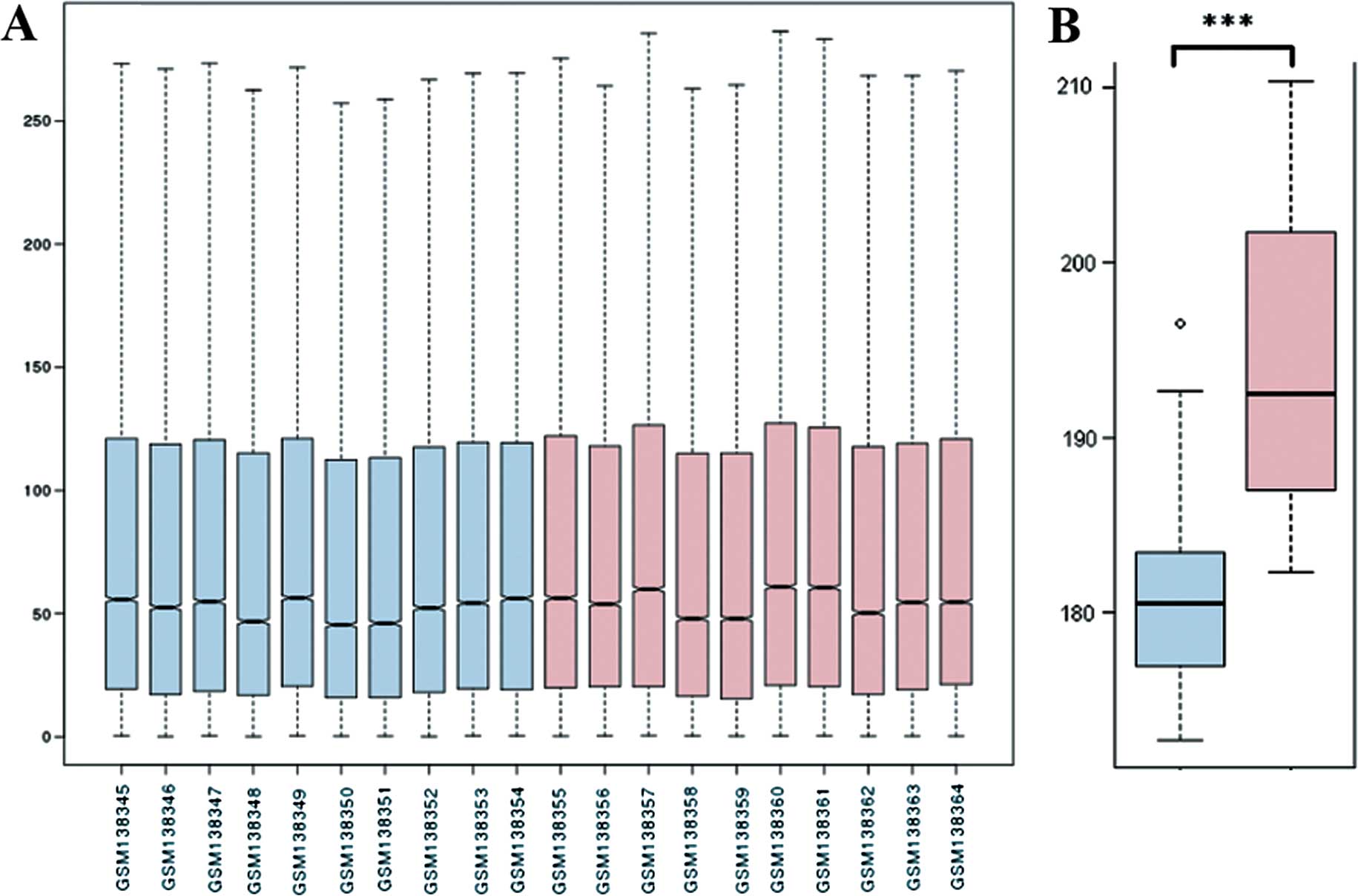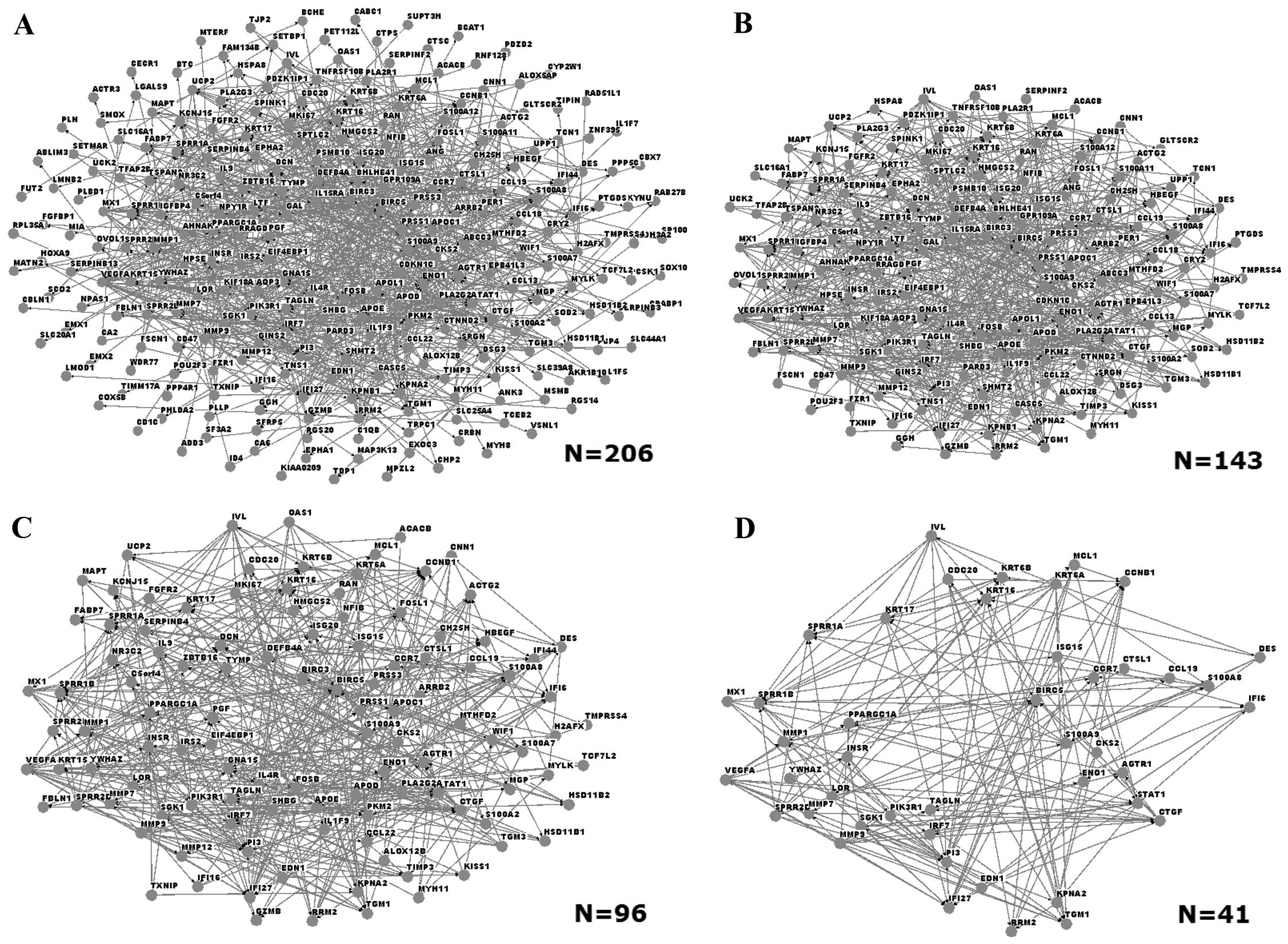|
1
|
Spergel JM and Paller AS: Atopic
dermatitis and the atopic march. J Allergy Clin Immunol.
112:S118–S127. 2003. View Article : Google Scholar : PubMed/NCBI
|
|
2
|
Leung DY: Atopic dermatitis: new insights
and opportunities for therapeutic intervention. J Allergy Clin
Immunol. 105:860–876. 2000. View Article : Google Scholar : PubMed/NCBI
|
|
3
|
Laughter D, Istvan JA, Tofte SJ and
Hanifin JM: The prevalence of atopic dermatitis in Oregon
schoolchildren. J Am Acad Dermatol. 43:649–655. 2000. View Article : Google Scholar : PubMed/NCBI
|
|
4
|
Johansson SG, Bieber T, Dahl R, et al:
Revised nomenclature for allergy for global use: Report of the
Nomenclature Review Committee of the World Allergy Organization,
October 2003. J Allergy Clin Immunol. 113:832–836. 2004. View Article : Google Scholar : PubMed/NCBI
|
|
5
|
Beltrani VS: Atopic dermatitis: an update.
J Allergy Clin Immunol. 104:S85–S86. 1999. View Article : Google Scholar : PubMed/NCBI
|
|
6
|
McGirt LY and Beck LA: Innate immune
defects in atopic dermatitis. J Allergy Clin Immunol. 118:202–208.
2006. View Article : Google Scholar : PubMed/NCBI
|
|
7
|
De Benedetto A, Agnihothri R, McGirt LY,
Bankova LG and Beck LA: Atopic dermatitis: a disease caused by
innate immune defects? J Invest Dermatol. 129:14–30.
2009.PubMed/NCBI
|
|
8
|
Novak N, Bieber T and Leung DY: Immune
mechanisms leading to atopic dermatitis. J Allergy Clin Immunol.
112:S128–S139. 2003. View Article : Google Scholar : PubMed/NCBI
|
|
9
|
Akdis CA, Akdis M, Bieber T, et al:
Diagnosis and treatment of atopic dermatitis in children and
adults: European Academy of Allergology and Clinical
Immunology/American Academy of Allergy, Asthma and
Immunology/PRACTALL Consensus Report. Allergy. 61:969–987. 2006.
View Article : Google Scholar
|
|
10
|
Leung DY: Atopic dermatitis: immunobiology
and treatment with immune modulators. Clin Exp Immunol. 107(Suppl
1): 25–30. 1997.PubMed/NCBI
|
|
11
|
Toda M and Ono SJ: Genomics and proteomics
of allergic disease. Immunology. 106:1–10. 2002. View Article : Google Scholar : PubMed/NCBI
|
|
12
|
Morar N, Willis-Owen SA, Moffatt MF and
Cookson WO: The genetics of atopic dermatitis. J Allergy Clin
Immunol. 118:24–34. 2006. View Article : Google Scholar
|
|
13
|
Park YD, Kim SY, Jang HS, et al: Towards a
proteomic analysis of atopic dermatitis: a
two-dimensional-polyacrylamide gel electrophoresis/mass
spectrometric analysis of cultured patient-derived fibroblasts.
Proteomics. 4:3446–3455. 2004. View Article : Google Scholar : PubMed/NCBI
|
|
14
|
Merryman-Simpson AE, Wood SH, Fretwell N,
et al: Gene (mRNA) expression in canine atopic dermatitis:
microarray analysis. Vet Dermatol. 19:59–66. 2008. View Article : Google Scholar : PubMed/NCBI
|
|
15
|
Nomura I, Gao B, Boguniewicz M, Darst MA,
Travers JB and Leung DY: Distinct patterns of gene expression in
the skin lesions of atopic dermatitis and psoriasis: a gene
microarray analysis. J Allergy Clin Immunol. 112:1195–1202. 2003.
View Article : Google Scholar : PubMed/NCBI
|
|
16
|
Olsson M, Broberg A, Jernas M, et al:
Increased expression of aquaporin 3 in atopic eczema. Allergy.
61:1132–1137. 2006. View Article : Google Scholar : PubMed/NCBI
|
|
17
|
Mobini R, Andersson BA, Erjefalt J, et al:
A module-based analytical strategy to identify novel
disease-associated genes shows an inhibitory role for interleukin 7
receptor in allergic inflammation. BMC Syst Biol. 3:192009.
View Article : Google Scholar
|
|
18
|
Williams H, Jburney P, Hay R, et al: The
U.K. Working Party’s diagnostic criteria for atopic dermatitis. I
Derivation of a minimum set of discriminators for atopic
dermatitis. Br J Dermatol. 131:383–396. 1994.
|
|
19
|
Troyanskaya O, Cantor M, Sherlock G, et
al: Missing value estimation methods for DNA microarrays.
Bioinformatics. 17:520–525. 2001. View Article : Google Scholar : PubMed/NCBI
|
|
20
|
Fujita A, Sato JR, Rodrigues Lde O,
Ferreira CE and Sogayar MC: Evaluating different methods of
microarray data normalization. BMC Bioinformatics. 7:4692006.
View Article : Google Scholar : PubMed/NCBI
|
|
21
|
Smyth GK: Limma: linear models for
microarray data. Bioinformatics and Computational Biology Solutions
Using R and Bioconductor. Gentleman R, Carey V, Huber W, Irizarry R
and Dudoit S: Springer; New York: pp. 397–420. 2005, View Article : Google Scholar
|
|
22
|
Dudoit S, Schaffer J and Boldrick J:
Multiple hypothesis testing in microarray experiments. Statist Sci.
18:71–103. 2003. View Article : Google Scholar
|
|
23
|
Breitkreutz BJ, Stark C and Tyers M:
Osprey: a network visualization system. Genome Biol. 4:R222003.
View Article : Google Scholar : PubMed/NCBI
|
|
24
|
Willis RC and Hogue CW: Searching,
viewing, and visualizing data in the Biomolecular Interaction
Network Database (BIND). Curr Protoc Bioinformatics. Chapter 8(Unit
8.9)2006. View Article : Google Scholar
|
|
25
|
Breitkreutz BJ, Stark C and Tyers M: The
GRID: the general repository for interaction datasets. Genome Biol.
4:R232003. View Article : Google Scholar : PubMed/NCBI
|
|
26
|
Estrada E: Virtual identification of
essential proteins within the protein interaction network of yeast.
Proteomics. 6:35–40. 2006. View Article : Google Scholar : PubMed/NCBI
|
|
27
|
Jeong H, Mason SP, Barabasi AL and Oltvai
ZN: Lethality and centrality in protein networks. Nature.
411:41–42. 2001. View
Article : Google Scholar : PubMed/NCBI
|
|
28
|
Huang da W, Sherman BT and Lempicki RA:
Systematic and integrative analysis of large gene lists using DAVID
bioinformatics resources. Nat Protoc. 4:44–57. 2009.PubMed/NCBI
|
|
29
|
Zhang B, Kirov S and Snoddy J: WebGestalt:
an integrated system for exploring gene sets in various biological
contexts. Nucleic Acids Res. 33:W741–W748. 2005. View Article : Google Scholar : PubMed/NCBI
|
|
30
|
Duncan D, Prodduturi N and Zhang B:
WebGestalt2: an updated and expanded version of the Web-based Gene
Set Analysis Toolkit. BMC Bioinformatics. 11:1. 2010. View Article : Google Scholar
|
|
31
|
Kim BE, Leung DYM, Boguniewicz M and
Howell MD: Loricrin and involucrin expression is down-regulated by
Th2 cytokines through STAT-6. Clin Immunol. 126:332–337. 2008.
View Article : Google Scholar : PubMed/NCBI
|
|
32
|
Nakai K, Yoneda K, Hosokawa Y, et al:
Reduced expression of epidermal growth factor receptor, E-cadherin,
and occludin in the skin of flaky tail mice is due to filaggrin and
loricrin deficiencies. Am J Pathol. 181:969–977. 2012. View Article : Google Scholar : PubMed/NCBI
|
|
33
|
Sevilla LM, Nachat R, Groot KR, et al:
Mice deficient in involucrin, envoplakin, and periplakin have a
defective epidermal barrier. J Cell Biol. 179:1599–1612. 2007.
View Article : Google Scholar : PubMed/NCBI
|
|
34
|
Komine M, Freedberg IM and Blumenberg M:
Regulation of epidermal expression of keratin K17 in inflammatory
skin diseases. J Invest Dermatol. 107:569–575. 1996. View Article : Google Scholar : PubMed/NCBI
|
|
35
|
Hobbs RP, Lessard JC and Coulombe PA:
Keratin intermediate filament proteins - novel regulators of
inflammation and immunity in skin. J Cell Sci. 125:5257–5258. 2012.
View Article : Google Scholar : PubMed/NCBI
|
|
36
|
Depianto D, Kerns ML, Dlugosz AA and
Coulombe PA: Keratin 17 promotes epithelial proliferation and tumor
growth by polarizing the immune response in skin. Nat Genet.
42:910–914. 2010. View
Article : Google Scholar : PubMed/NCBI
|
|
37
|
Theerawatanasirikul S, Sailasuta A,
Thanawongnuwech R and Suriyaphol G: Alterations of keratins,
involucrin and filaggrin gene expression in canine atopic
dermatitis. Res Vet Sci. 93:1287–1292. 2012. View Article : Google Scholar : PubMed/NCBI
|
|
38
|
Hohl D, de Viragh PA, Amiguet-Barras F,
Gibbs S, Backendorf C and Huber M: The small proline-rich proteins
constitute a multigene family of differentially regulated cornified
cell envelope precursor proteins. J Invest Dermatol. 104:902–909.
1995. View Article : Google Scholar : PubMed/NCBI
|
|
39
|
Zimmermann N, Doepker MP, Witte DP, et al:
Expression and regulation of small proline-rich protein 2 in
allergic inflammation. Am J Respir Cell Mol Biol. 32:428–435. 2005.
View Article : Google Scholar : PubMed/NCBI
|
|
40
|
Sallusto F: The role of chemokine
receptors in primary, effector and memory immune response. Exp
Dermatol. 11:476–478. 2002. View Article : Google Scholar
|
|
41
|
Kakinuma T, Saeki H, Tsunemi Y, et al:
Increased serum cutaneous T cell-attracting chemokine (CCL27)
levels in patients with atopic dermatitis and psoriasis vulgaris. J
Allergy Clin Immunol. 111:592–597. 2003. View Article : Google Scholar : PubMed/NCBI
|
|
42
|
Gunther C, Bello-Fernandez C, Kopp T, et
al: CCL18 is expressed in atopic dermatitis and mediates skin
homing of human memory T cells. J Immunol. 174:1723–1728. 2005.
View Article : Google Scholar : PubMed/NCBI
|
|
43
|
Shimada Y, Takehara K and Sato S: Both Th2
and Th1 chemokines (TARC/CCL17, MDC/CCL22, and Mig/CXCL9) are
elevated in sera from patients with atopic dermatitis. J Dermatol
Sci. 34:201–208. 2004. View Article : Google Scholar : PubMed/NCBI
|
|
44
|
Heishi M, Kagaya S, Katsunuma T, et al:
High-density oligonucleotide array analysis of mRNA transcripts in
peripheral blood cells of severe atopic dermatitis patients. Int
Arch Allergy Immunol. 129:57–66. 2002. View Article : Google Scholar : PubMed/NCBI
|
|
45
|
Suarez-Farinas M, Tintle SJ, Shemer A, et
al: Nonlesional atopic dermatitis skin is characterized by broad
terminal differentiation defects and variable immune abnormalities.
J Allergy Clin Immunol. 127:954–964. 2011. View Article : Google Scholar : PubMed/NCBI
|
|
46
|
Parvaneh N, Casanova JL, Notarangelo LD
and Conley ME: Primary immunodeficiencies: a rapidly evolving
story. J Allergy Clin Immunol. 131:314–323. 2013. View Article : Google Scholar : PubMed/NCBI
|
|
47
|
Watanabe O, Tamari M, Natori K, et al:
Loci on murine chromosomes 7 and 13 that modify the phenotype of
the NOA mouse, an animal model of atopic dermatitis. J Hum Genet.
46:221–224. 2001. View Article : Google Scholar : PubMed/NCBI
|
|
48
|
Heinzmann A and Daser A: Mouse models for
the genetic dissection of atopy. Int Arch Allergy Immunol.
127:170–180. 2002. View Article : Google Scholar : PubMed/NCBI
|












